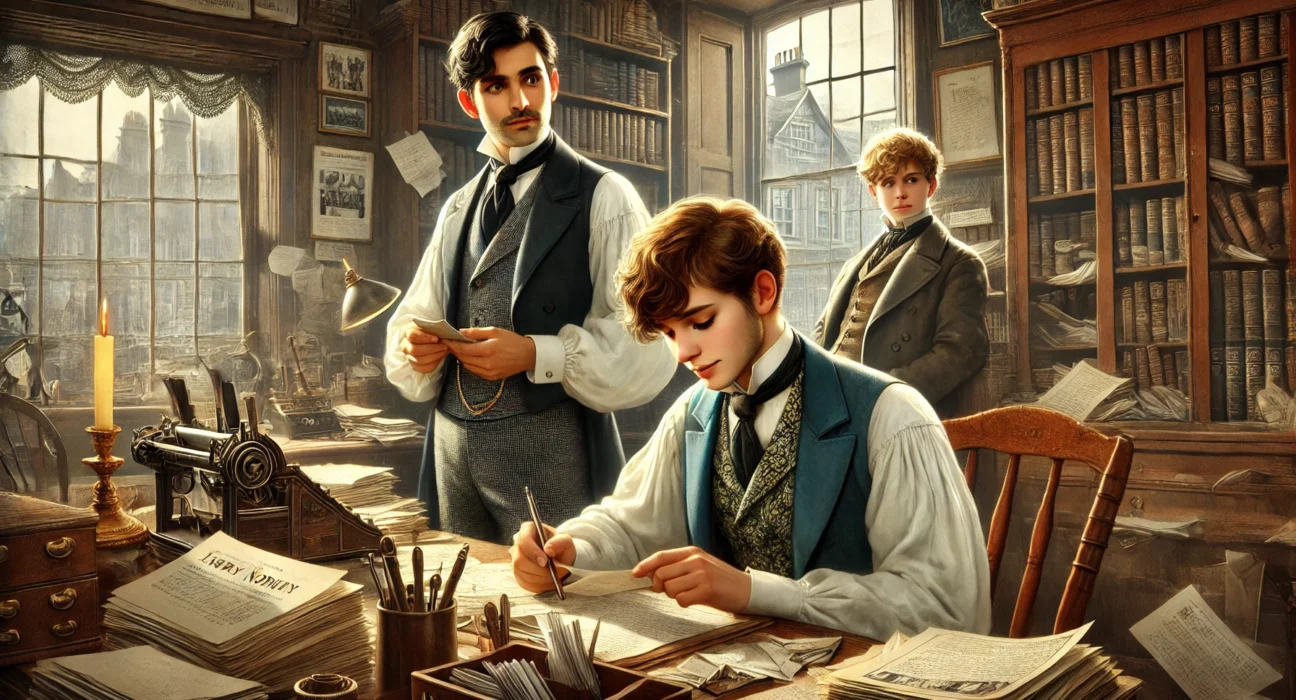The Three Clerks, published in 1857 by Anthony Trollope, is a satirical and insightful exploration of the British civil service during the Victorian era. Set against the backdrop of the government office system, the novel examines the lives of three young clerks—Henry Norman, Alaric Tudor, and Charley Tudor—navigating their careers and personal lives. The novel delves into themes of ambition, morality, and love, while highlighting the bureaucratic world through Trollope’s witty and often humorous lens.
Plot Summary
Alaric Tudor, Henry Norman, and Charley Tudor, three young men, begin their careers as clerks in the British civil service, each full of ambition and promise, yet with vastly different temperaments and aspirations. Henry Norman, the most morally upright of the trio, is a man of principles, dedicated to his work and unflinchingly honest. Alaric Tudor, more ambitious and cunning, is willing to bend ethical boundaries in his quest for success. Meanwhile, Charley, the youngest and most carefree, enjoys the pleasures of a reckless, youthful life, often ignoring the responsibilities and discipline his position requires.
Their lives intertwine not only through their work but also through their shared social circle, particularly their connections to the Woodward family. Mrs. Woodward, a widow, lives with her three daughters—Gertrude, Linda, and Katie—in a picturesque cottage near the Thames. The Woodwards become an essential part of the young clerks’ lives, offering friendship, romance, and, at times, emotional turmoil.
Henry Norman and Alaric Tudor are both drawn to Gertrude, the eldest of the Woodward sisters. She is a sensible and strong-willed woman, and both men admire her. However, Henry, with his moral rectitude, finds himself holding back, unsure of his own feelings and hesitant to pursue her. Alaric, on the other hand, is more aggressive in his affections. His charm and ambition eventually win Gertrude’s heart, and they become engaged.
Despite Alaric’s engagement, his ambition begins to lead him down dangerous paths. He rises swiftly within the civil service, aided by his ability to manipulate and navigate the political landscape. He is driven not only by the desire for professional success but also by the allure of wealth and status. Alaric’s ambition blinds him to the consequences of his actions, and soon, he becomes involved in financial speculations with a dubious politician named Undy Scott. These dealings, although promising quick financial gains, are built on unstable ground.
Charley Tudor, meanwhile, is less concerned with career or ambition. His youth and exuberance lead him into a life of indulgence, frequenting taverns and falling into debt. Despite his reckless behavior, he finds a place in the Woodward family’s hearts, particularly in the affections of the youngest daughter, Katie. Katie, innocent and kind-hearted, sees something redeemable in Charley, despite his flaws. Her love for him begins to anchor Charley, drawing him away from his wild ways and helping him realize the consequences of his actions.
While Charley struggles to reform, Alaric’s life begins to spiral out of control. His financial speculations with Undy Scott turn sour, and his debts begin to mount. Desperate to maintain his reputation and lifestyle, Alaric becomes more reckless, eventually committing an act of embezzlement. His crime is soon discovered, and his world unravels. The shame of his actions devastates not only his career but also his engagement to Gertrude. She, heartbroken by his betrayal, must come to terms with the fact that the man she loved has compromised his integrity in pursuit of success.
Henry Norman, throughout this period, remains steadfast in his moral convictions. His love for Gertrude, though unspoken for much of the time, never wavers. He watches as Alaric’s choices lead to his downfall, but rather than revel in his rival’s failure, he is deeply saddened by the tragedy of it all. In the end, it is Henry’s unwavering character that provides solace to the Woodward family. Gertrude, in the aftermath of her broken engagement, gradually realizes that it is Henry’s quiet strength and honesty that she truly values.
Charley, influenced by Katie’s love and the sobering lessons of Alaric’s downfall, finally begins to take his life more seriously. His transformation is gradual but significant, as he works to reform his ways and repay his debts. With Katie’s support, he finds a path toward redemption, offering a glimpse of hope for a better future.
Alaric’s fall from grace is swift and brutal. His embezzlement leads to public disgrace, and he is sentenced to prison for his crime. His ambition, which had once seemed admirable, becomes his undoing, serving as a cautionary tale about the dangers of placing career advancement above personal integrity. Alone and disgraced, Alaric must face the consequences of his actions, while his former friends and loved ones move forward without him.
In the end, Henry and Gertrude’s relationship blossoms into one of mutual respect and affection. The love that was once overshadowed by Alaric’s charm and ambition now grows steadily, rooted in shared values and a deep emotional bond. Charley, too, finds his redemption through Katie’s love and his determination to change. The Woodward family, despite the trials they endure, emerges stronger, with Gertrude and Katie finding happiness with men who have earned their love through perseverance and integrity.
In this tale of ambition, love, and moral choices, the characters are shaped by the decisions they make and the consequences they face. Alaric’s tragic fall serves as a stark reminder of the dangers of unchecked ambition, while Henry and Charley’s quieter, more measured paths lead them toward love, redemption, and personal fulfillment.
Main Characters
Henry Norman: Norman is portrayed as a serious, principled young man, committed to his career in the Weights and Measures Office. His high moral standards make him a steadfast character, although this same moral rigidity leads him to make certain difficult decisions. Throughout the novel, his loyalty and honor are tested, particularly in his relationships with his colleagues and in matters of love.
Alaric Tudor: Alaric, more ambitious and cunning than his friend Henry, is a clerk who rises quickly within the bureaucratic system. His ambition, however, is coupled with a willingness to bend moral rules, making him a complex character who teeters between integrity and manipulation. His character arc is central to the exploration of the dangers of unchecked ambition.
Charley Tudor: Charley is the youngest of the three clerks and Alaric’s cousin. He is carefree, reckless, and often falls prey to the temptations of a hedonistic lifestyle, which causes problems in his professional and personal life. Charley’s journey is one of maturation, as he begins to face the consequences of his irresponsible choices.
Katie Woodward: Katie is the youngest of the three Woodward sisters and the love interest of Charley Tudor. Her innocence and purity contrast sharply with the sometimes morally ambiguous world around her. She becomes a key emotional center in the narrative, particularly in her relationship with Charley.
Gertrude Woodward: The eldest of the Woodward sisters, Gertrude is a strong and sensible character. She becomes romantically involved with Alaric Tudor, whose ambition and duplicity cause tension in their relationship.
Theme
Ambition and Morality: The novel explores the tension between personal ambition and moral integrity, particularly through the character of Alaric Tudor. His rise in the civil service comes at the cost of his ethical principles, illustrating the dangers of placing career success above moral righteousness.
Bureaucratic Satire: Trollope provides a biting critique of the civil service, poking fun at its inefficiencies and the absurdities of government offices. Through the depiction of the “Weights and Measures” and “Internal Navigation” departments, Trollope illustrates the red tape and incompetence prevalent in these institutions.
Social Mobility: The novel delves into the Victorian era’s concerns with class and social mobility, particularly through the characters’ attempts to rise in both their professional and social spheres. Alaric’s pursuit of success and Charley’s careless approach to his future highlight the different paths available to men of their standing.
Love and Relationships: Romantic entanglements are a key part of the narrative, especially in the relationships between the clerks and the Woodward sisters. The novel examines how love can both uplift and complicate lives, particularly when intertwined with ambition and moral choices.
Writing Style and Tone
Trollope’s writing in The Three Clerks is marked by a satirical and humorous tone, often using wit to criticize the inefficiencies and pretensions of the Victorian bureaucracy. His portrayal of the civil service is both sharp and playful, capturing the mundane yet ridiculous aspects of office life. Trollope uses irony extensively, particularly in his depiction of characters like Alaric Tudor, whose moral compromises are highlighted by the contrast between their self-perception and reality.
The narrative style is detailed and leisurely, reflecting Trollope’s penchant for character-driven storytelling. He employs a third-person omniscient narrator, allowing deep insight into the thoughts and motivations of his characters. This narrative technique enables Trollope to explore their psychological complexity, particularly in moments of moral conflict. His descriptive passages are vivid, particularly when portraying settings like the bustling offices or the tranquil countryside of Hampton, where the Woodward family resides. The tone, while often lighthearted, also carries moments of emotional depth, particularly in the novel’s exploration of love and ethical dilemmas.
We hope this summary has sparked your interest and would appreciate you following Celsius 233 on social media:
There’s a treasure trove of other fascinating book summaries waiting for you. Check out our collection of stories that inspire, thrill, and provoke thought, just like this one by checking out the Book Shelf or the Library
Remember, while our summaries capture the essence, they can never replace the full experience of reading the book. If this summary intrigued you, consider diving into the complete story – buy the book and immerse yourself in the author’s original work.
If you want to request a book summary, click here.
When Saurabh is not working/watching football/reading books/traveling, you can reach him via Twitter/X, LinkedIn, or Threads
Restart reading!








